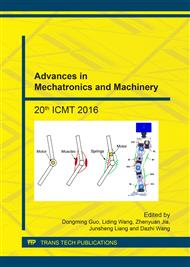[1]
W. Guo, S. H. Wang, C. G. Su, W. Y. Li, X. Y. Xu, L. Y. Cui, Method for precise controlling of the at shift control system, Int. J. Automot. Technol., vol. 15, no. 4, p.683–698, Jun. (2014).
DOI: 10.1007/s12239-014-0071-1
Google Scholar
[2]
X. Ye, Z. Jin, X. Hu, Y. Li, Q. Lu, Modeling and control strategy development of a parallel hybrid electric bus, Int. J. Automot. Technol., vol. 14, no. 6, p.971–985, Dec. (2013).
DOI: 10.1007/s12239-013-0107-y
Google Scholar
[3]
J. Wang, Q. N. Wang, P. Y. Wang, J. N. Wang, N. W. Zou, Hybrid electric vehicle modeling accuracy verification and global optimal control algorithm research, Int. J. Automot. Technol., vol. 16, no. 3, p.513–524, Jun. (2015).
DOI: 10.1007/s12239-015-0053-y
Google Scholar
[4]
B. -Z. Gao, H. Chen, X. -H. Lu, K. Sanada, Improved optimal controller for start-up of amt trucks in consideration of drivers intention, Int. J. Automot. Technol., vol. 14, no. 2, p.213–220, Apr. (2013).
DOI: 10.1007/s12239-013-0024-0
Google Scholar
[5]
G. L. Gissinger, C. Menard, and A. Constans, A mechatronic conception of a new intelligent braking system, Control Eng. Pract., vol. 11, no. 2, p.163–170, (2003).
DOI: 10.1016/s0967-0661(02)00041-2
Google Scholar
[6]
L. Iannelli, Transmission, in Encyclopedia of Systems and Control, no. 1, London: Springer London, 2014, p.1–9.
Google Scholar
[7]
M. Pisaturo, A. Senatore, Improvement of Traction Through mMPC in Linear Vehicle Dynamics Based on Electrohydraulic Dry-Clutch, Intell. Ind. Syst., vol. 1, no. 2, p.153–161, (2015).
DOI: 10.1007/s40903-015-0017-6
Google Scholar
[8]
A. Myklebust, L. Eriksson, Modeling, Observability, and Estimation of Thermal Effects and Aging on Transmitted Torque in a Heavy Duty Truck With a Dry Clutch, IEEE/ASME Trans. Mechatronics, vol. 20, no. 1, p.61–72, Feb. (2015).
DOI: 10.1109/tmech.2014.2303859
Google Scholar
[9]
N. Kim, H. Lohse-Busch, A. Rousseau, Development of a model of the dual clutch transmission in autonomie and validation with dynamometer test data, Int. J. Automot. Technol., vol. 15, no. 2, p.263–271, Mar. (2014).
DOI: 10.1007/s12239-014-0027-5
Google Scholar
[10]
M. Pisaturo, A. Senatore, Simulation of engagement control in automotive dry-clutch and temperature field analysis through finite element model, Appl. Therm. Eng., vol. 93, p.958–966, (2016).
DOI: 10.1016/j.applthermaleng.2015.10.068
Google Scholar
[11]
F. Huang, Y. Mo, J. Lv, Study on heat fading of phenolic resin friction material for micro-automobile clutch, 2010 Int. Conf. Meas. Technol. Mechatronics Autom. ICMTMA 2010, vol. 3, p.596–599, (2010).
DOI: 10.1109/icmtma.2010.386
Google Scholar
[12]
A. A. Yevtushenko, A. Adamowicz, P. Grzes, Three-dimensional FE model for the calculation of temperature of a disc brake at temperature-dependent coefficients of friction, Int. Commun. Heat Mass Transf., vol. 42, p.18–24, (2013).
DOI: 10.1016/j.icheatmasstransfer.2012.12.015
Google Scholar
[13]
L. Wawrzonek, R. A. Bialecki, Temperature in a disk brake, simulation and experimental verification, Int. J. Numer. Methods Heat Fluid Flow, vol. 18, no. 3/4, p.387–400, (2008).
DOI: 10.1108/09615530810853646
Google Scholar
[14]
R. Felger, C. Spandern, M. Häßler, H. -D. Elison, Innovative clutch facing materials – Cool facings for hot applications!, in LuK Symposium 2006, 2006, p.47–53.
Google Scholar
[15]
R-233 Friction Characteristics from Small Sample Tests - Technical data, (1996).
Google Scholar
[16]
O. I. Abdullah and J. Schlattmann, Finite Element Analysis of Temperature Field in Automotive Dry Friction Clutch, Tribol. Ind., vol. 34, no. 4, p.206–216, (2012).
Google Scholar
[17]
O. I. Abdullah and J. Schlattmann, Finite Element Analysis for Grooved Dry Friction Clutch, Adv. Mech. Eng. its Appl., vol. 2, no. 1, p.121–133, (2012).
Google Scholar
[18]
O. I. Abdullah and J. Schlattmann, Computation of surface temperatures and energy dissipation in dry friction clutches for varying torque with time, Int. J. Automot. Technol., vol. 15, no. 5, p.733–740, Aug. (2014).
DOI: 10.1007/s12239-014-0076-9
Google Scholar
[19]
Y. Wang, Y. Li, N. Li, H. Sun, C. Wu, T. Zhang, Time-varying friction thermal characteristics research on a dry clutch, Proc. Inst. Mech. Eng. Part D J. Automob. Eng., vol. 228, no. 5, p.510–517, Apr. (2014).
DOI: 10.1177/0954407013516434
Google Scholar
[20]
N. Cappetti, M. Pisaturo, A. Senatore, Modelling the cushion spring characteristic to enhance the automated dry-clutch performance: The temperature effect, Proc. Inst. Mech. Eng. Part D J. Automob. Eng., vol. 226, no. 11, p.1472–1482, (2012).
DOI: 10.1177/0954407012445967
Google Scholar
[21]
M. Pisaturo, C. D'Auria, and A. Senatore, Friction coefficient influence on the engagement uncertainty in dry-clutch AMT, Proc. of American Control Conference ACC 2016, pp.7561-7566, (2016).
DOI: 10.1109/acc.2016.7526867
Google Scholar


